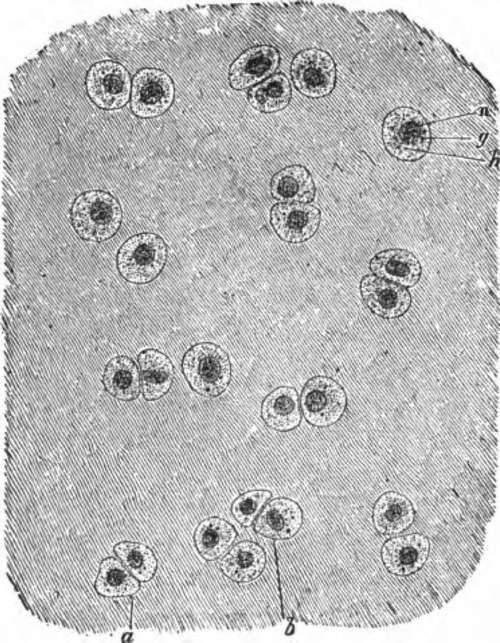Chapter IV. The Skeleton
Description
This section is from the book "The Human Body: An Elementary Text-Book Of Anatomy, Physiology, And Hygiene", by H. Newell Martin. Also available from Amazon: The Human Body.
Chapter IV. The Skeleton
The skeleton * of the human body is composed of three materials : bone, cartilage, and connective tissue.
The bones form the main supporting framework of the body, and determine its shape ; they provide levers on which the muscles moving the body pull, and are arranged so as to surround cavities in which soft, delicate organs, as brain, spinal cord, and heart, may lie in safety.
Cartilage finishes off many bones at joints, forming elastic pads with smooth surfaces; it is also used instead of bones in some parts of the skeleton where considerable flexibility is required. Cartilage affords one of the best tissues of the body for the examination of intercellular substance. A thin slice of it highly magnified, Fig. 7, shows the cartilage cells, a, b, scattered through an almost structureless material. Very young cartilage consists of the cells only, but these lay down around them more and intercellular substance, until at last it forms the main bulk of the cartilage, and gives this the elasticity and flexibility for which it is used in the body.
Of what is the skeleton made up ? What functions do the bones fulfill ? Where is cartilage found ? What are its purposes ? What is seen when a thin slice of cartilage is highly magnified ? Of what does young cartilage consist.
* There are two kinds of skeleton met with in the animal kingdom; the external skeleton or exoskeleton, and the internal skeleton or endoskeleton. The exoskeleton is made by the skin, either in it or on it; examples are found in the shells of clams and lobsters: the scales of fishes and snakes; the tortoise-shell of turtles; the feathers of birds; the hair and claws of beasts. In man the exoskeleton is only Slightly developed; hair, nails and teeth belong to it.

Fig. 7. A thin slice of curtilage highly magnified.
Continue to:
- prev: Distillation
- Table of Contents
- next: Connective Tissue
